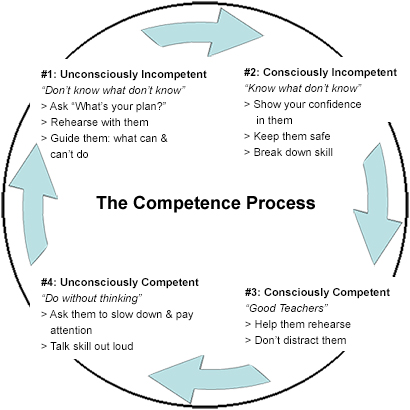The Competence Process has evolved in the field of psychology from a theory developed by the Thomas Gordon Institute. It asserts that we all go through a four stage learning process to achieve competency with any skill. Once we move into the final stage, the cycle begins again. It follows then that it is our role as clinical educators to coach and support students in making the transition from one stage to another.
- Unconsciously Incompetent
In this first stage, the learner does not have enough knowledge to know what they don’t know. Awareness is required in order to recognize deficits as well as an awareness of the significance of the skill to motivate the transition from being unconsciously incompetent to consciously incompetent…to knowing what they don’t know.
Teaching strategies include:
- Rehearsal of the skill, verbally or physically.
- Gentle guidance through the skill without judgment.
- Consciously Incompetent
With awareness, the learner now knows what they don’t know. This is a very vulnerable and uncomfortable place to be and is where virtually all of our clinical students function. This is where the learning edge exists. It is where the growth takes place. In order to gain the competence and confidence to move into a more secure place, practice is required; often a fair amount of practice. In order for the practice to work in building the confidence required to transition into the next stage, a tremendous amount of positive support and encouragement is critical.
Teaching strategies include:
- Support & encouragement can help keep learners on track. A high tolerance for mistakes and gaps is necessary, as this is where learners are most apt to be very self-deprecating.
- Fear breeds hesitation and students need reminding that you will keep them safe and not set them up for failure or embarrassment.
- Break down the skill into steps and sequences so it will be easier to learn.
- Repetition, repetition, repetition.
- Consciously Competent
With enough practice, learners are now competent but may be focused on every step of the procedure. Learners who are consciously competent are often good teachers since they can easily explain the steps and the reasoning behind the skill. They can become critical of others at this time because they are so acutely aware of the ‘right way”. In order for them to be able to move past the technical part of the skill and be able to concentrate on something else other than performing the task, experience is the essential element. They now know how to ‘do things right”.
Teaching strategies include:
- Continue to help them to mentally or physically rehearse the skill before doing it.
- Don’t distract them when they are doing the skill unless a mistake is about to be made.
- Unconsciously Competent
This is when the learner stops thinking about every step and performs it without thinking about it. Over time they forget the theoretical principles and steps behind each procedure and may find it hard to explain what the steps are. The unconsciousness can easily set the stage for a return to stage 1. This is where the learner can take a step back to ask themselves if they are ‘doing the right thing”.
Teaching strategies include:
- Ask questions about rationale at unpredictable times.
- Suggest they talk out loud about how to do the skill as they are doing it.
- If appropriate, give explanations to the patient while they are providing care.
